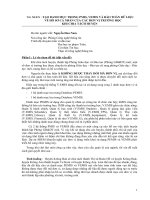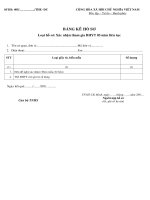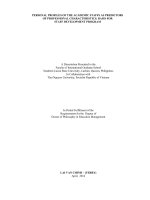hồ sơ cá nhân
Bạn đang xem bản rút gọn của tài liệu. Xem và tải ngay bản đầy đủ của tài liệu tại đây (113.93 KB, 5 trang )
THE 28
TH
CONFERENCE OF THE FEDERATION OF ENGINEERING
ORGANIZATIONS
CAFEO 28 HANOI VIETNAM, 30
TH
NOV. - 2
ND
DEC., 2010
TITLE:
Offshore Pipeline RBI Methodology M Hisham
Noraswad
AUTHOR(S)’
NAME(S):
Mohd Hisham Abu Bakar, Pipeline Engineer
Noraswad B M Daud, Pipeline Engineer
ORGANIZATION
& DESIGNATION:
PETRONAS Group Technical Solutions
ADDRESS:
Pipeline Department, Level 7, Menara Dayabumi,
50050 Kuala Lumpur, MALAYSIA
TEL:
0196618070
FAX:
0327836061
EMAIL:
Requirements:
1. The report is obliged to have above information
2. The report should not be longer than 10 pages (A4 size); if longer then an executive
summary of the paper is required.
3. Font: Times New Roman, Single line,
4. Font size: 12
Executive Summary
This presentation outlines the basic philosophy underpinning the methods of evaluating the
probability and consequence of failure, making assessment of the risk level, and concluding on the
appropriate actions that need to be taken to manage the identified risk for offshore pipeline system.
Risk-Based Inspection (RBI) is a means to design and optimize an inspection scheme based on the
performance of a risk assessment progress using historical database, analytical methods and
experience & engineering judgment. The objective of RBI is to aid the development of optimized
inspection, monitoring and testing plans for meeting specified system acceptance criteria. In RBI
analysis process, ‘high risk’ areas and major failure modes are identified and analyzed. Thus, it will
lead us to target inspection and maintenance resources at these areas of the structure / system where
they can have the greatest effect in reducing risk, the occurrence likelihood and consequences of
unplanned failures, and to reduce the cost of unproductive inspections. Among the reasons for
selecting a risk based approach to inspection planning are: to focus inspection effort upon items
where the safety or economic risks are identified as being high, to correspondingly reduce the
inspection effort applied to identified low risk systems, to ensure that the overall pipeline system
risk acceptance criteria, as set by the operator, are not exceeded, to achieve an optimal schedule for
the inspection activities, to identify and apply the optimal inspection or monitoring methods
according to the identified degradation mechanisms.
Introduction
Detailed Assessment in Risk Based Inspection (RBI) is a method used to effectively manage risk by
focusing inspection on high risk items. It optimizes the inspection efforts by balancing inspection
costs with inspection benefits and the risks present. The damage causes that will be investigated
include metal loss from corrosion i.e. internal corrosion, external corrosion, erosion (if detected),
on-bottom stability, external impact & freespan.
The Risk is usually defined as a product of Probability of Failure (POF) times the Consequence of
Failure (COF).
Risk = POF X COF
Pipeline failure may result from various causes and its probability of failure (POF) may be
determined from knowledge of degradation rates. In the PCSB RBI methodology, six damage
causes are considered. The six damage causes are further categorized into two: time-based and
event-based. Time-based damage causes are those whose severity increases with time e.g. internal
corrosion, external corrosion and erosion. Event-based damage causes are those whose probability
of occurrence is relatively constant over time e.g. dropped object. The modeling of POF and COF is
explained in the following sections.
Risk Modeling
To simplify the calculation of probability of failure (POF), we have considered only the causes
which have significant impact on the pipelines. Although complete statistical data is unavailable,
pipeline operator operational experience indicates that most pipeline failures (leak or burst) in
pipeline operator region are attributed to metal loss corrosion. This is time-based failure mode
which includes both internal and external corrosion. The least common damage cause is failure due
to erosion.
It is noted that other degradation mechanisms, whose degradation rate may not be amenable to
mathematical modeling, can also cause pipeline failure. The probability of failure (POF) category
for event-based failure mode e.g. freespan, on bottom stability and external impact will be based on
the PCSB RBI manual.
Consequence of failure (COF) may be divided into safety, environment and economic
consequences. However, in the absence of rigorous consequence modeling such as a quantitative
risk analysis (QRA), the DNV approach of safety class is adopted. According to DNV-OS-F101,
the acceptable probability of failure (POF) for ultimate limit state (a condition in which certain
limits are exceeded and failure can occur) is related to safety classes as given below:
Table 1: Safety class and target annual failure probability for Ultimate Limit State (ULS)
Safety Classes Indicating a target annual failure probability for
probability of:
High < 10-5
Normal < 10-4
Low < 10-3
The safety classes are dependent on category of fluid transported and location of pipeline as
presented in the following table and detailed in DNV-OS-F101.
Table 2: Safety class dependent on Product, Manning and Location Class
Product
Unmanned
Installation
Manned Installation
All Location
Classes
Location Class 1 Location Class 2
Flammable Product Normal Normal High
Water & Non-
flammable Product
Low Low Normal
Location classes are categorized as follows:
Table 3: Typical location classes
Location Class Definition
1 The area where no frequent human activity is anticipated along
the pipeline route (> 500 m from platform or shore)
2 The area where frequent human activity is anticipated along the
pipeline route (<500 m from platform or shore)
Using this approach a defect on a water injection pipeline located on a riser would have an annual
POF limit = 10-4 because its location class = 2 (for riser) and safety class = Normal (for water in
location class 2). Similarly, a defect on a hydrocarbon gas pipeline, or a crude pipeline on the
onshore portion of the pipeline would have annual POF limit = 10-5 because its location class = 2
(for onshore) and safety class = High (for flammable product in location class 2).
Both POF and COF, hence risk, are time-dependent. The POF is a function of many parameters
among which are pipeline geometry and defect geometry. Defect geometry is in turn a function of
corrosion rate as modeled in the following equation:
⎥
⎦
⎤
⎢
⎣
⎡
Δ
+
⎟
⎠
⎞
⎜
⎝
⎛
=
t
T
CR
t
d
t
d
initial
defect depth growth equation
From the above equation, defect depth (d/t) will grow over time (∆T) from an initial defect size due
to corrosion rate (i.e. CR > 0 mm/yr). The defect depth growth equation contains is modeled as a
statistical distribution with a specified coefficient of variation. The use of statistical distribution for
CR result in (d/t) that follows the distribution as depicted in the following diagram. The distribution
for (d/t) moves to the right as T increases (i.e. T given in number of years elapsed as time
progresses).
Pipeline operated under internal pressure has an allowable defect depth (d/t)max and length L
above which failure of the pipeline is imminent. The shaded area in the diagram indicates the
probability of which the pipeline is expected to fail because the defect depth has exceeded the
allowable defect depth for a given defect length. The area under the curve to the right of (d/t)max
gives POF. This is the region calculated in RBI software as POF. Initially, say at T=1 when defect
size is small, the POF is also small. Over time, as the defect grows, its POF increases. The next
inspection date is reached when POF has reached 10-4 or 10-5 as appropriate according to the
safety class for the defect.
Figure 1: Illustration of predicted future deterioration
Risk Calculation
Using this methodology risk is not explicitly calculated. For simplicity, consequence of failure
(COF) is assumed constant and fixed through the safety class approach and risk is increased by the
probability of failure (POF) component. The limit for setting the next inspection date is therefore
set by the POF. Inspection is recommended when the POF has reached a specified limit.
d/t
T=1 T=3
T=5
d/t
max
Where d/t > d/t
max
, POF
d/t
T=1 T=3
T=5
d/t
max
Where d/t > d/t
max
, POF









